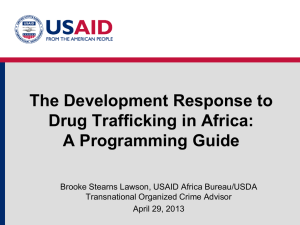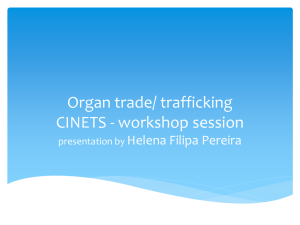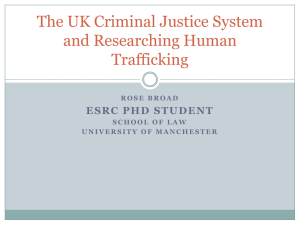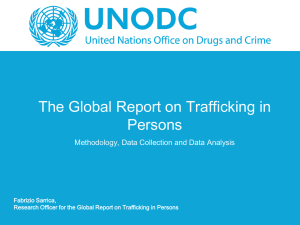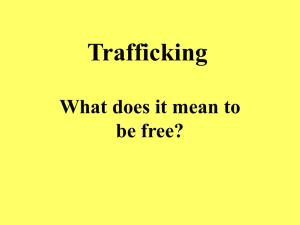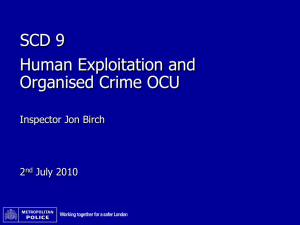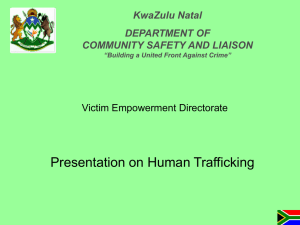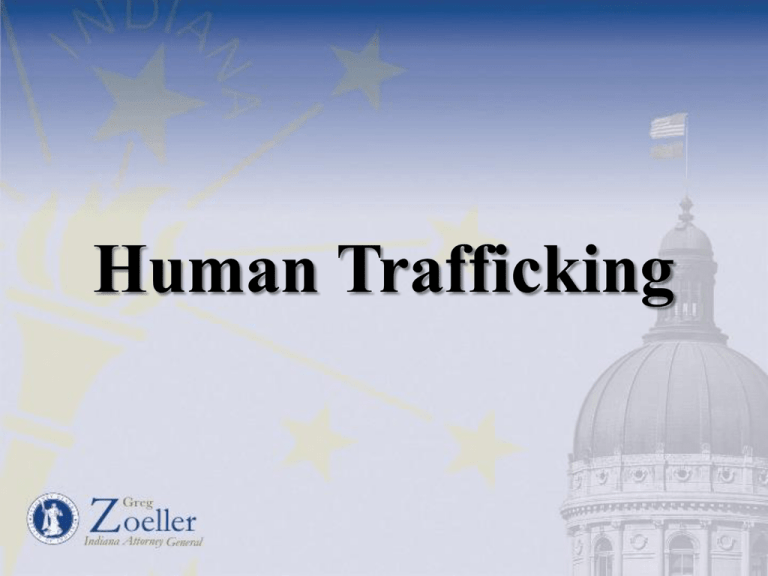
Human Trafficking
IPATH
Indiana Protection for Abused and Trafficked Humans Task Force
PREVENTION, PROTECTION, PROSECUTION
The Indiana Protection for Abused Trafficked Humans task force (IPATH)
is one of 42 task forces nationwide funded by the Department of Justice’s
Office of Victims of Crime and the Bureau of Justice Assistance to address
the issue of human trafficking.
The Goals of IPATH are to:
1) Enhance law enforcement’s ability to identify and rescue victims.
2) Provide resources and training to identify and rescue victims.
3) Ensure comprehensive services are available for victims of trafficking.
What is Human Trafficking?
Sex Trafficking: in which a commercial sex act is induced by force, fraud,
or coercion, or in which the person induced to perform such act has not
attained 18 years of age; or
Labor Trafficking: The recruitment, harboring, transportation, provision,
or obtaining of a person for labor or services, through the use of force, fraud,
or coercion for the purpose of subjection to involuntary servitude, peonage,
debt bondage, or slavery. (1)
1)
Victims of Trafficking and Violence Protection Act of 2000, Pub. L. No. 106-386 (2000), available at
http://www.state.gov/documents/organization/10492.pdf.
Human Trafficking Examples
Sex Trafficking Example:
A 17 year old girl* runs away from
her abusive family for the second
time. She meets a 20-something
man at the mall who befriends her
and offers to buy her something
pretty. Their romantic relationship
grows slowly as she becomes more
dependent upon him and believes
he loves her. He starts to ask her to
do things for him, eventually
leading to pimping her out for
profit and resorting to violence and
psychological trauma to control
her.
Labor Trafficking Example:
After losing his factory job*, a 35-year
old man answers a job advertisement
in the local newspaper for skilled
welders. The ad promises affordable,
safe housing and good pay. However,
after being coerced into signing a
“contract” in English, which he does
not speak, he is taken to his home: a 2bedroom apartment housing 8 other
men, costing him $600 per month. The
men are transported to a restaurant
where they work 15 hours a day and
their living costs always outnumber
their pay, causing them to become
burdened by an ever increasing debt.
*Stories are fictional and meant to be used for instructional use only.
While they include common elements of human trafficking, these
narratives are not taken from any one trafficking survivor.
A Growing Problem Worldwide
Human Trafficking is tied as the SECOND LARGEST and FASTEST growing criminal
industry in the world, just behind the drug trade. (1)
27 million people are estimated to
be victims of human trafficking
worldwide. (2)
161 countries identified as being
affected by human trafficking. (3)
$150.2 billion dollars generated by
forced labor worldwide. (4)
1)
2)
3)
4)
5)
(5)
Administration for Children & Families, U.S. DEPT. OF HEALTH & HUMAN SERVICES, http://www.acf.hhs.gov/trafficking/about/index.html (last visited Jan. 13, 2012).
U.S. Dept. of State Trafficking in Persons Report (2013), available at http://www.state.gov/j/tip/rls/tiprpt/2013/index.htm.
UN OFFICE OF DRUGS AND CRIME, TIP REPORT: GLOBAL PATTERNS (2006) at p.58, available at http://www.unodc.org/pdf/traffickinginpersons_report_2006ver2.pdf.
INTERNATIONAL LABOUR OFFICE, PROFITS AND POVERTY: THE ECONOMICS OF FORCED LABOUR (2014), available at http://www.ilo.org/wcmsp5/groups/public/--ed_norm/---declaration/documents/publication/wcms_243391.pdf. See also REMARKS AT THE RELEASE OF THE 2014 TRAFFICKING IN PERSONS REPORT, U.S. DEPT. OF
STATE (June 20, 2014) available at http://www.state.gov/secretary/remarks/2014/06/228083.htm. See also CIVILIAN SECURITY, DEMOCRACY, AND HUMAN RIGHTS: THE
ECONOMICS OF FORCED LABOR, U.S. DEPT. OF STATE (June 2014), available at http://www.state.gov/secretary/remarks/2014/06/228083.htm.
U.S. DEPARTMENT OF STATE, THE FACTS ABOUT CHILD SEX TOURISM (2005) at p.22 (2005), available at http://www.state.gov/documents/organization/47255.pdf.
A Growing Problem Here at Home
Nearly 300,000 American youths are at risk of
becoming victims of commercial sexual
exploitation, according to the FBI. (2)
12-14 is the average age of entry into commercial
sex in the U.S. (3)
83% of sex trafficking victims found in the U.S.
were U.S. citizens, according to one Justice
Department study (4)
1)
2)
3)
4)
(1)
U.S. DEPT. OF STATE TRAFFICKING IN PERSONS REPORT (2010), available at http://www.state.gov/g/tip/rls/tiprpt/2010/index.htm; see also CONGRESSIONAL RESEARCH SERVICE, TRAFFICKING IN
PERSONS: U.S. POLICY AND ISSUES FOR CONGRESS (2010) at p.2, available at http://www.unhcr.org/refworld/topic,4565c22535,4565c25f42b,4d2d96e62,0,USCRS,,.html.
Amanda Walker-Rodriguez & Rodney Hill, Human Sex Trafficking, FED. BUREAU INVESTIGATION (Mar. 2011), http://www.fbi.gov/statsservices/publications/lawenforcementbulletin/march_2011/human_sex_trafficking
Some research indicates that the average age of entry for U.S. girls is 12 to 14, while the average age for U.S. boys and transgender youth is 11 to 13. See Amanda Walker-Rodriguez and Rodney Hill,
Human Sex Trafficking, FBI LAW ENFORCEMENT BULLETIN, (March, 2011), available at http://www.fbi.gov/stats-services/publications/law-enforcement-bulletin/march_2011/human_sex_trafficking.
See also POLARIS PROJECT, CHILD SEX TRAFFICKING AT-A-GLANCE, (2011), available at http://loveandlighttofreedom.org/uploads/Child_Sex_Trafficking__Polaris_Project-_Jan_2012_.pdf. See also
Ernie Allen, President and CEO of the National Center for Missing and Exploited Children, speaking to the House Victims’ Rights Caucus Human Trafficking Caucus, Cong. Rec., 111th Cong., 2nd
sess., 2010. See also U.S. Children are Victims of Sex Trafficking (April 2008), HUMANTRAFFICKING.ORG, http://www.humantrafficking.org/updates/801.
This statistic is based on one study of confirmed sex trafficking incidents opened by federally funded U.S. task forces. Human Trafficking/Trafficking In Persons, Dept. of Justice, Bureau of Justice
Statistics, http://bjs.ojp.usdoj.gov/index.cfm?ty=tp&tid=40 (last visited 1/14/2012).
Midwest/Indiana Statistics
Investigations in US
BJA Funded Anti5,143 (2007-2012)
Trafficking Task Forces
Investigations in
Midwest
392 (2007-2012)
(1)
Investigations in
Indiana (2006-June,
2014)
134 (law enforcement)
and 123 victims served
to date
US Statistics- Fiscal Year 2012
(2)
26 DOJ-led taskforces
Number of Investigations in the US
over 753
ICE-HSI
894
FBI
306 pending (adults and foreign child victims)
440 (sex trafficking of children)
1) Information was obtained from the Bureau of Justice Assistance (BJA). The BJA Task Forces in the Midwestern Region were located in the states of: Illinois,
Indiana, Missouri, Wisconsin, and Minnesota.
2) U.S. Dept. of State Trafficking in Persons Report (2013), available at http://www.state.gov/j/tip/rls/tiprpt/2013/index.htm.
Origin & Destination Countries
The United States is one of the most popular
destinations for human trafficking.
UN Highlights Human Trafficking, ORIGIN & DESTINATION COUNTRIES, BBC NEWS available at http://news.bbc.co.uk/2/hi/in_depth/6497799.stm.
Who is Involved in Trafficking?
• The recruiter gains the victim’s trust and then sells them for
labor or to a pimp. Sometimes this is a boyfriend, a neighbor,
or even a family member.
• The trafficker is the one who controls the victims. Making
the victim fearful through abuse, threats, and lies the trafficker
gains power over his/her victim.
• The victim could be anyone.
• The consumer funds the human trafficking industry by
purchasing goods and services. Often s/he is unaware that
someone is suffering.
The Trafficker
•The trafficker will likely be
in a lucrative business
enterprise as the heart of
human trafficking is
exploiting cheap labor.
•The trafficker may be part
of a larger organized crime
ring, or may be profiting
independently.
•Most often, he/she is the
same race/ethnicity as the
victim.
• Might be someone who knew
the victim and victim’s family.
• Will likely be bilingual.
• Will likely be an older man
with younger women who
seems to be controlling,
watching their every move, and
correcting/instructing them
frequently.
The Trafficked Person
Human Trafficking reaches every culture and demographics. Regardless
of their demographics, victims are vulnerable in some way, and the
traffickers will use their particular vulnerability to exploit the victim.
Some risk factors include:
– Youth
– Poverty
– Unemployment
– Desperation
– Homes in countries torn by armed conflict, civil unrest, political
upheaval, corruption, or natural disasters
– Family backgrounds strife with violence, abuse, conflict
– Homelessness
– A need to be loved
– Immigration Status
Child Trafficking Victims Experience High Levels of
Adversity and Stress
Jim Mercy, Division of Violence Prevention, National Center for Injury Prevention and Control, Centers for Disease Control and Prevention, The
Public Health Implications of Child Sex Trafficking (PowerPoint presentation).
The Adverse Childhood Experience Studies
Jim Mercy, Division of Violence Prevention, National Center for Injury Prevention and Control, Centers for Disease Control and Prevention, The
Public Health Implications of Child Sex Trafficking (PowerPoint presentation).
The Trafficked Person
A Vulnerable Life Before Victimization *
Of boys and girls recruited into commercial sex:
•
57% had been sexually abused as children. (1)
•
49% had been physically assaulted. (1)
•
85% were victims of incest as girls, and 90% had been physically abused. (2)
•
61.5% were frequently hit, slapped, pushed, grabbed, or had objects thrown at them by a
member of their household. (3)
•
40% of the above were kicked, hit, beaten, raped, or threatened and/or attacked with a weapon
by a member of their household. (3)
•
Nearly half the participants in one study had been “molested or raped as children or teenagers.”
(4)
* These studies considered various forms commercial sex, not only sex trafficking. Due to the hidden nature of this crime, little research is
available strictly on trafficking. However, it should be noted that anyone used in commercial sex who is under 18 or is being forced or
coerced is a victim of trafficking.
1)
2)
3)
4)
Melissa Farley & Howard Barkan, Prostitution, Violence Against Women, and Posttraumatic Stress Disorder, 27 WOMEN & HEALTH 37-49 (1998), available at
http://www.prostitutionresearch.com/ProsViolPosttrauStress.html.
Hunter, S.K., Prostitution is Cruelty and Abuse to Women and Children, 1 MICH. J. GENDER & L. 1-14 (1993).
Jody Raphael & Deborah L. Shapiro, SISTERS SPEAK OUT: THE LIVES AND NEEDS OF PROSTITUTED WOMEN IN CHICAGO, CENTER FOR IMPACT RESEARCH (2002) at p.15,
available at http://www.impactresearch.org/documents/sistersspeakout.pdf.
Jennifer K. Wesely, Growing up Sexualized: Issues of Power and Violence in the Lives of Female Exotic Dancers, 8 No. 10 Violence Against Women, 1182, 1192 (October,
2002).
Throughout life children exposed to trauma / PTSD:
•
•
•
•
•
•
•
•
•
•
•
More substance use problems and domestic violence
Use more mental health services
Less likely to complete secondary or advanced education
More trouble attaining and holding stable employment
More disrupted –less trusting relationships
More problems with criminal justice system
More verbally, physically abusive to their others/own children
Experience more homelessness
Longer the exposure, worse the outcomes
More life long physical health care services
On average will die 20 years younger
WILLIAM HOLMES, MD & ROY VANTASSELL MS LPC, When the Twig is Bent: An Integrated Approach to Children In Foster Care (Apr.
22-24, 2014), PPT for National RX Drug Abuse Summit.
Children in Foster Care and Post
Traumatic Stress Disorder
• One study of foster care children found PTSD for 60% of children
who had been sexually abused, 42% of children who had been
physically abused (1)
• A study of kids ages 6-8 entering foster care found that one out of
three met criteria for PTSD (2)
• Another study found PTSD symptoms in 19.2% of child welfare
investigated kids placed in foster care (3)
• Over 21% of foster care alumni suffer from PTSD, a rate higher than
U.S. war veterans (4)
1.
2.
3.
4.
Dubner, A. E., & Motta, R. W. (1999). Sexually and physically abused foster care children and posttraumatic stress disorder. Journal Of Consulting And Clinical
Psychology, 67(3), 367-373. doi:10.1037/0022-006X.67.3.367
Marsenich, L. (2002). Evidence-based practices in mental health services for foster youth. Sacramento, CA: California Institute for Mental Health. Available at
http://www.casey.org/resources/publications/pdf/improvingfamilyfostercare_fr.pdf
Kolko, D. J., Hurlburt, M. S., Jinjin, Z., Barth, R. P., Leslie, L. K., & Burns, B. J. (2010). Posttraumatic Stress symptoms in children and adolescents referred for child
welfare investigation. Child Maltreatment, 15(1), 48-63.
Pecora, P., Kessler, R., Williams, J., O’Brien, K., Downs, A.C., English, D., …. Holmes, K. E. (2005). Improving foster care—Findings from the Northwest Foster
Care Alumni Study. Seattle, WA: Casey Family Programs.
The Trafficked Person
• Likely has been lied to about the work they will be doing in the U.S.
• Was economically motivated to come the United States or to seek a new
job.
• Believes they have a real debt to pay and takes this very seriously.
• Has been lied to about their rights in this country and what will happen to
them if they seek help.
• Does not have any meaningful social network.
• Is extremely embarrassed about what is happening to him/her.
• May not see themselves as a victim – they may feel blame for their
situation.
• May be holding out hope that if he or she proves their worth, things will get
better
Where are Trafficked Persons
Found?
Trafficking is found in many industries including:
•
•
•
•
•
•
•
•
•
The sex industry
Forced labor in agricultural or construction industries
Factories, restaurants, hotels
domestic servitude as servant, housekeeper or nanny
Health and beauty industries
As a bride
As beggars or peddlers
Janitorial services
Health and elder care
How Are People Recruited?
•
•
•
•
•
•
•
•
Grooming process
Internet and social media
Fake employment agencies
Acquaintances or family
Newspaper ads
Front businesses
Word of mouth
Abduction
Why don’t Trafficked Persons Escape?
• They are afraid of being deported.
• They may be in danger if they try to leave.
• The traffickers have such a strong psychological and physiological
hold on them.
• They fear for the safety of their families in their home countries or
in the U.S.
• They may fear the U.S. legal system because they may not
understand the laws that protect them.
• They may not be able to support themselves on their own.
• Due to all these factors, they may not complain about their situation.
Therefore, it is our responsibility to protect
and assist people being exploited.
Human Trafficking and Technology
Social Networking
Traffickers may pose as
any of the following on
social media:
Escort Service
Modeling Agency
Dancing Opportunity
Boyfriend
Friend
This kind of approach
works more often than
parents would like to
believe.
http://money.cnn.com/2013/02/27/technology/social/pimps-social-networks/index.html
Human Trafficking and Technology
Online Classified Ads – Craigslist.org and Backpage.com
1)
Human Trafficking and Technology
Online Classified Ads – Craigslist.org and Backpage.com
A study conducted by KLAAS KIDS Foundation
found significant increases in Backpage escort ads
leading up to the 2012 Super Bowl. (1)
An artist’s interpretation of
an advertisement on
Indianapolis Backpage
February 02nd. (2)
1)
2)
KLAAS KIDS FOUNDATION, TACKLE THE TRAFFICKER OUTREACH
KLAAS KIDS FOUNDATION, BEHIND CLOSED DOORS.
AND
MONITORING INITIATIVE (Feb. 3, 2011).
Three Elements of Trafficking
In order to be considered trafficking on both federal and state
levels, all three of these elements must be identified:
Recruiting
Harboring,
PROCESSor
Moving,
Obtaining
A person
By
Force,
MEANS
Fraud or
Coercion
For the purpose
of
Involuntary
servitude,
Debt bondage,
Slavery or
Sex Trade
END
What is Force, Fraud, & Coercion?
Force
Fraud
Coercion
Kidnapping
Promises of Valid Immigration
Debt Bondage
Torture
Documents
Threats of Harm to Victim or
Battering
Victim told to use false travel
Family
Threats with Weapons
papers
Control of Children
Sexual Abuse
Contract signed for Legitimate Work
Controlled Communication
Confinement
Promised Job differs from actuality
Photographing in Illegal
Forced use of Drugs
Promises of Money or Salary
Situations
Forced Abortions
Misrepresentation of Work Conditions
Holding ID/Travel Documents
Denial of Medical Care
Wooing into Romantic
Verbal or Psychological Abuse
Relationship
Control of Victims Money
Punishments for Misbehavior
Indiana Law: IC 35-42-3.5-1
• Trafficking:
– A person who, by force, threat of force, or fraud engages a person in:
•
•
•
•
•
Forced Labor
Involuntary Servitude
Marriage
Prostitution
Participation in Sexual Conduct
• Prosecutors don’t have to prove force when a minor under the age of
18 is being trafficked
• Restitution is available to trafficking victims
• Trafficking victims may also have a civil cause of action to recover
other damages from the trafficker
Human and Sexual Trafficking, Ind. Code § 35-42-3.5, available at
http://www.in.gov/legislative/ic/code/title35/ar42/ch3.5.pdf.
Criminal Code Felony reclassification effective July 1, 2014.
Federal Law: Trafficking Victims
Protection Act of 2000
A Comprehensive Law:
Areas of Focus:
– Prevention
• Public Awareness, Outreach and Education
– Protection
• T-Visa, Certification, Benefits and Services to Victims
– Prosecution
• Created Federal Crime of Trafficking, New Law
Enforcement Tools and Efforts
Highlights of TVPA:
•Protection provided to trafficked persons through
legal assistance and other benefits
•New crimes of trafficking and forced labor defined
•State Department reports annually on how countries
are doing in combating trafficking
–Lowest ranked countries are subject to sanctions
What is a T-Visa?
• Enables certain victims of human trafficking to live and work in the US for
four years.
– May be eligible to apply for adjustment of status to lawful
permanent resident after three years.
• Can petition to have certain family members accompany them.
• Allows access to public benefits.
• Cap of 5,000 visas annually.
– From 2002 through October, 2012, only 6,482 visas were issued.
– The reason the number of issued visas is so low is believed to be
because human trafficking victims are not coming forward.
Social Service Provision
Adult victims of a severe form of trafficking may be eligible for
valuable legal & social service benefits:
•Mental health care
•Interpretation
•Legal and immigration
services
•Safety planning
•ESL training
•Food
•Independent living skills
•Job placement and
employment education
•Clothing
•Housing
•Medical care and health
education
Who Might Identify Trafficked
Persons?
Referrals about human trafficking cases can come through a variety of
means:
–
–
–
–
–
–
–
–
–
Other Social Service Agencies
Local Law Enforcement
Labor Issue Complaints
Federal Investigations
Local/National Hotlines
Other Government Agencies
Churches
Concerned Community Members
Immigrant Officers
Identification: Social Indicators
• Potential victim is accompanied by another person who seems
controlling and/or insists on speaking for the victim
• Frequent relocation
• Numerous inconsistencies in his or her story
• Neglected healthcare needs
• Are not in control of their own money
• Lack of control of identification documents
• Individual is using false identification papers
• Restricted or scripted communication
Rescue and Restore Campaign
The National Symposium on the Health Needs of Human Trafficking Victims
Shared Hope International
Identification: Social Indicators
• Excess amount of cash
• Hotel room keys
• Chronic runaway/homeless youth
• Signs of branding (tattoo, jewelry)
• Lying about age
• Lack of knowledge of a given community or whereabouts
• Exhibits behaviors including hyper-vigilance or paranoia,
nervousness, tension, submission, etc.
Rescue and Restore Campaign
The National Symposium on the Health Needs of Human Trafficking Victims
Shared Hope International
Identification: Health Indicators
• Signs of physical abuse
– Bruises
• Poor Dental Hygiene
• Psychological Problems
– Black Eyes
– Depression
– Burns
– Anxiety
– Cuts
– PTSD
– Broken teeth
– Suicidal Ideation
– Multiple scars
– Panic Attacks
• Malnourishment
– Stockholm Syndrome
• Evidence of trauma
– Fear/Distrust
POLARIS PROJECT AT A GLANCE FOR MEDICAL PROFESSIONALS (2010), available at http://www.cicatelli.org/titlex/downloadable/Polaris%20Project%20At-AGlance%20for%20Medical%20Professionals%20Final.pdf.
Key Questions to Keep in Mind
1.
2.
3.
Are they being forced to do
something they don’t want to do?
Is the person allowed to leave their
place of work?
Has the person been physically
and/or sexually abused?
4.
Has the person been threatened?
5.
Does the person have a passport and
other documents, or are they taken
away?
6.
Has the person been paid for his/her
work or services?
7.
How many hours does the person
work a day?
8.
What are/were the living conditions?
9.
How did the person find out about
the job?
10.
Who organized the person’s
migration?
11.
Do they have to ask permission to
eat, sleep, or go to the bathroom?
12.
Do they believe they owe money for
their travel or other expenses?
13.
Has anyone threatened their family?
14.
Where do they sleep and eat?
15.
Is there a lock on their door or
windows so they cannot get out?
What Can You Do?
Commit to not participating in the
commercial sex industry…
– To not purchase or participate in
prostitution or the commercial sex
industry
– To hold friends accountable and
demand their respect for women and
children
– To take action on behalf of those
vulnerable to sex trafficking
Talk about it.
– Talk to your friends about the fact that
there is a direct connection between
prostitution, lap dancing and strip clubs
and missing and exploited children.
– In interviews, Johns admit that they would
be deterred from buying sex if they were
held criminally and socially
accountable.
Speak out.
Take part in creating cultural change.
– Encourage education for youth on
topics such as healthy relationships,
self-identity, life skills…
– Support local organizations that serve
victims of human trafficking
– Don’t tolerate or use the lingo. When
prostitution is portrayed as a choice
or “funny” in movies, talk about the
reality. Don’t glorify the “pimp” culture.
– Share these facts with others.
To access “Don’t Buy the Lie” human trafficking materials, please visit the Human Trafficking webpage under Office
Initiatives on the Indiana Attorney General’s website: http://www.in.gov/attorneygeneral/humantrafficking/
What Can You Do – Promote Education for Youth
Human Trafficking 101:
– 45-minute informational overview of trafficking
• Definition of terms,
• A look at who is involved,
• Action steps for how youth can be involved in standing up against this problem.
Empowering Youth to End Sexual Exploitation:
– Four 45-minute sessions
– Looks at cultural myths, trends, and influences that feed into sex trafficking
and sexual exploitation
– Engages youth in activities, critical thinking, and learning to become change
agents
My Life, My Choice:
– 10-session course for adolescent females
– Geared toward at risk or former victims of trafficking
– Covers topics such as reducing risks of exploitation, developing self-esteem,
and sexual health
If you believe someone is a victim of
Human Trafficking:
• Call 911 if there is an emergency or crime occurring currently.
• Then…
– Indianapolis Trafficked Persons Assistance Program 24-hour
hotline 1-800-928-6403
– National Human Trafficking Resource Center Hotline Number
1-888-3737-888 or send a text to BeFree (233733)
– Indiana Child Abuse and Neglect Hotline Number
1-800-800-5556
Contact:
Office of the Indiana Attorney General
Human Trafficking Prevention Program
humantraffickinginfo@atg.in.gov




